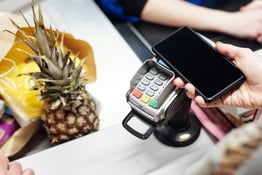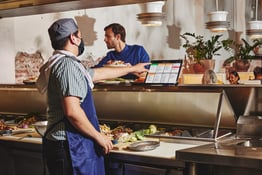The hospitality biz isn’t exactly famous for attracting data nerds. A mind for calculating percentages on the fly (quick, 18% of $50, go!) and a general familiarity with fractions and basic accounting are enough to get started working in a restaurant, if not running one.
So long as you’re selling your food at a decent markup, not overstaffing in slow times, and keeping rent low, you can probably master small data. Your customers’ names. Whether they like their gin with a lime. Whether or not your regular is married, so you don’t greet his plus-1 with “nice to see you again” if you, y'know, haven’t.
If you’re looking to level up, though, it might be time to be thinking bigger when you consider data. Restaurants now have an extraordinary amount of information available to them. It's generated when they make a sale. It's generated when a customer visits a website or downloads an app. It's even generated when people simply wander in with a cell phone.
This sort of data lets you do more than simply start pouring your regular her favorite beer when she walks through the door. It can help you understand and respond to your customers — and find new customers with a minimum of ad spending — with a sophistication that's becoming standard in new restaurant technologies. It might be time to consider a customer data platform, or CDP, to collect and analyze this data, and then connect it to actions that can drive business for you.
What is a customer data platform?
In its simplest terms, a CDP is a database. Specifically, it’s a database that contains information about your customer, often assembled from a variety of sources. The data (just another word for information) coming into that database involves some fact about your customer.
Some of that data will be demographic: How old is he? Where does he live? What’s his income bracket? What does he do for a living?
Some of that data will be behavioral: How often does she visit your restaurant website? Has she downloaded your app? At what time of day does she visit your restaurant? And on which days of the week?
And other data will be transactional: How much do they spend on a typical order? What do they like to order? When they visit, do they tend to come alone, or bring a crowd?
Your CDP will gather the data from behaviors and transactions that your restaurant can directly collect (what’s called first-party data). Then, the CDP combines that with data from other sources such as social media comments and outside purchase orders (second-party data), along with data the customer themself provides (zero-party data), to assemble a deeply informed profile of this person.
As you can imagine, you get enough data on enough customers and pretty soon you have a good idea of your existing customers, as well as a way to infer the kind of person who isn’t an existing customer yet, but who might want to be, if you marketed to them. That’s called a look-alike audience, and CDPs are perfect for identifying and find them.
What can a customer data platform do for your restaurant?
Using data to gain insights about your customers has the obvious first benefit of helping you understand the reality of your business. Maybe you started a restaurant aiming to serve young, single professionals in their 20s … but the data shows that most of your customers now are in their 30s and married. Maybe you think spending on an app is paying off … but the data shows that your most dedicated repeat customers never use it anyway. Knowing what’s actually happening in your restaurant is the first step to making good decisions.
The second big benefit of knowing about your customers is that it allows you to target your ad spending, so that you’re not spraying your restaurant marketing budget into the void. Having robust customer data lets you choose narrow places to put your ad dollars, and gauge whether those campaigns are in fact working.
A CDP optimized for restaurants will also be able to track and warehouse data from cell phones when people visit. Even a person paying cash, or a five-person table where one person pays the entire check, can thereby offer up a trove of usable, if anonymous, data.
The job of a CDP is to collect all of this data — which arrives from a zillion directions as a flurry of digital clutter — and to sort through it, giving you a coherent view of your customer that you can then translate into specific actions. Usually, that’s some kind of highly personalized marketing campaign.
That can take lots of forms; for restaurants, a few of the most effective might be to inform your customer loyalty program (which will often include a CDP), to run cost-effective promotions, and to run smart “win-back” campaigns that bring in customers you haven’t seen in a while.
What should you look for in a CDP for your restaurant?
You want your CDP to be robust and flexible, able to ingest data from a variety of different sources. And you want it to be able to interface with other platforms, so that you can put your findings to use automatically. That way, if your customer is interacting with your website, your app, or even your POS, those systems can recognize and respond to them in real time, to drive the results you want to see.
You also want a platform that lets you set specific targets and measure them as they’re happening. All of this stuff is iterative, ultimately. You want to set goals, gather data, use the CDP to put that data toward your goals, and see how well it’s working. You need to be able to measure the effectiveness of your actions if you want to keep improving them.
Data’s wild stuff in its raw form — messy, noisy, potentially overwhelming. Assuming you don’t want this to turn into a second career as a data scientist, you’ll want to work with a CDP that analyzes and presents insights in whatever fashion makes sense for you. That might be in the form of a report, a dashboard, or automated marketing tools. Ideally, too, you can query the data with your own random curious questions without a giant hassle. In any case, be really clear upfront on what the options are and what’s going to be the best for your business.
You also want it to be secure. Seems obvious, but it’s important. You also want to have a responsive human being on the other end of this thing to answer questions as they arise. A reasonable CDP should be able to get up and running within a month or so.
At the very least, it needs to work smoothly and cleanly with your marketing platform. If you have questions, start by getting a recommendation from your marketing team.
When should you consider getting a CDP for your restaurant?
If you’re thinking about making the leap to a CDP, ask yourself three questions. Is there a pain point with your existing data? For instance, you’re trying to get multiple data streams to “talk” to one another, or you’re spending a ton of time futzing with your data, it might be time for a CDP. Are you big enough to have a dedicated marketer on staff? If so, they can probably do some cool, sophisticated stuff working with a CDP. Or do you just want to geek out on data, maybe experiment a bit? A CDP can help you do that.
[Photo by Helena Lopes from Pexels]





